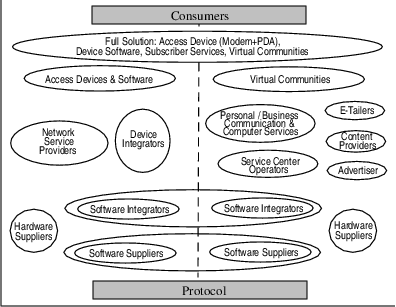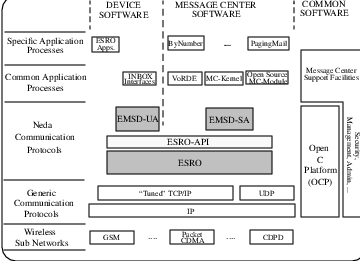Strategy for Making LEAP Widespread
Strategy for Making LEAP Widespread
Neda Communications, Inc.
info@neda.com
First Published: August 4, 2000
Last Updated: August 8, 2000
Copyright ©2000 Mohsen Banan
copies of this manual provided the copyright notice and
this permission notice are preserved on all copies.
A Component of The LEAP Manifesto
This article is one of a series of articles describing various aspects of the Mobile Messaging industry and the Lightweight &
Efficient Application Protocols (LEAP) protocols. For the complete collection of articles see The LEAP Manifesto [8], available
at
http://www.LeapForum.org/LEAP/Manifesto/roadMap/index.html. The LEAP Manifesto is also available at the Free
Protocols Foundation website at
http://www.FreeProtocols.org/LEAP/Manifesto/roadMap/index.html.
Contents
2 The Power of Free Software
2.1 Irrelevance of the Supply Chain Model
2.2 Bypassing the Telecommunications Gatekeepers
3 How LEAP Will Become Widespread
4 NEDA’s Free Software Base
5 Neda’s Free Software Licensing Strategy
List of Figures
List of Tables
1 Introduction
Thus far in The LEAP Manifesto our discussion has been largely theoretical; in previous articles we have demonstrated on paper that WAP is not viable [9], and that LEAP has all the characteristics necessary to be considered a viable alternative [7]. However this is all academic until the protocols are implemented as software and deployed in real world systems. In this article we describe our strategy for accomplishing this goal.
The key elements of our strategy are that (1) we have created software implementations of the protocols for most common platforms, and (2) this software will be made publicly available in the form of free software in open-source format.
In order for the LEAP protocols to become widely used, they must be implemented in the form of software solutions that are readily available for deployment by end-users. To this end, protocol engines have been implemented in the form of portable code which has been ported to a variety of platforms. On the device side, software has been implemented for pagers and cell-phones; for hand-held PCs and Palm Pilot (Palm OS, Windows CE, Palm PC); for Windows 98, Windows 95, and Windows NT; and for Pine (UNIX, Windows, DOS). On the message center side, software has been implemented for Solaris, Linux and NT.
2 The Power of Free Software
The enormous power of free software and Open-Source Software (OSS) has been well demonstrated by the tremendous success of such OSS systems as Linux, Imap, Sendmail, and various others. At this point it seems clear that creating a rich and powerful software system, then providing it as patent-free, free software, in open-source form, and at no cost to the user, is an extremely effective mechanism for encouraging its adoption and usage.
Our strategy for making LEAP widespread is based on the power of the Open-Source Software model. By making the base implementation available as free software, we are enabling anyone to expand or enhance it, or make it available on any open platform. This model reduces the end cost to the ultimate user, and frees the user from the restrictions of traditional commercial software.
For further discussion and information about the Open-Source Software model, see article [15]. Also, a particularly revealing analysis of OSS is provided by Microsoft’s infamous Halloween documents, [17], [16]. These leaked documents provide embarrassingly revealing insights into Microsoft’s viewpoint and attitude towards the threat posed by OSS.
On the face of it, the OSS model would appear to have little commercial application – giving away free software may be an unbeatable way of promoting its usage, but it would not appear to be a useful business strategy. However, four basic business models have been proposed based on OSS:
- Provide Secondary Services. The vendor/developer of the OSS system makes money by means of service contracts, customer integration, etc.
- Loss Leader for Market Entry. The vendor/developer of the OSS system uses the advantages of the OSS process (especially that of credibility) as a competitive advantage against established commercial vendors.
- Commoditizing Downstream Suppliers. The vendor/developer of the OSS system is also the producer of a product or service further in the value supply chain, and closer to the consumer.
- Standards Preemption. Because the OSS process can be argued to be a winner-take-all process, it may be to the advantage of the vendor/developer to seed the OSS market with its own codebase, so as to preempt a competitive codebase from taking hold.
These four models represent the current status of business thinking, regarding the possible business uses of the OSS model. All four of these business models are valid, and each represents a practical, workable business strategy.
2.1 Irrelevance of the Supply Chain Model
According to conventional supply chain analysis, a successful business model must satisfy the financial and other needs of all potential gatekeepers throughout the supply chain. The OSS model, however, renders the conventional supply chain model irrelevant.
If the protocol-based Mobile Messaging industry were to be looked at from the traditional supply chain point of view, the picture would look something like Figure 1. This figure shows the supply chain relationships among all the major players in the Mobile Messaging industry. According to the conventional wisdom, in order for a business model to work, it is necessary (though not sufficient) for all the companies in the chain to make profits and satisfy their non-financial needs. In the protocols-based model, the LEAP protocols, shown at the bottom of the figure, are the basic enabling technology for the entire industry. The Consumers, shown at the top of the figure, are the ultimate end-users of the industry products and services. In general, products and services flow from the bottom of the figure towards the top, while revenues flow from the top down towards the bottom.
Some of the key Mobile Messaging industry constituencies are the Modem Manufacturers (e.g. Novatel), the PDA Manufacturers (e.g. Palm), and the Network Service Providers (e.g. AT&T). Integrators such as OmniSky, who are bundling fully integrated solutions and focusing on direct Layer 7 relationships with the consumer, are best positioned to exploit the increasing returns opportunities of the Virtual Communities phenomenon [1].
Much of the success of WAP can be attributed to the WAP Forum’s masterful manipulation of the traditional supply chain model, and to their winning the support of all the relevant gate-keepers. The creation of the WAP Forum, and their accomodation of all the significant network operators, is the classical business execution of what is needed to make the supply chain work in one’s favor.
The OSS model, however, is completely different. The OSS model bypasses the traditional gatekeeper roles altogether, thereby rendering them irrelevant. Those gatekeepers who do not recognize that the End-to-End Internet model will make their gatekeeper role obsolete will sooner or later find themselves out in the cold. All four of the OSS models described in the previous section will fullfil their respective purposes. In addition to the OSS model, the Internet End-to-End model, which eliminates the WAP-like gateway model, is also in favor of LEAP.
In the telecommunications industry, the accomodation of gate-keepers and supply chain models have been traditional requirements of a successful strategy. However, we do not consider that tradition relevant in the context of LEAP. Instead, we consider that our main challenge will be to fully understand and direct the power of the Internet End-to-End and OSS models.
2.2 Bypassing the Telecommunications Gatekeepers
The strength and effectiveness of the Mobile Messaging industry requires cooperation and understanding among several players, including mobile device manufacturers, wireless network operators, ISPs, and software providers.
Two of the key players are the telephone companies and the wireless network operators. We will refer to these two players collectively as the Telecommunications Industry. For largely historical reasons, the Telecommunications Industry tends to have a different culture and set of attitudes than the broader Data Communications Industry.
Most of today’s closed wireless data networks are monopolies, or have their roots as monopolies. Also, the operation of these wireless networks is similar to the operation of phone companies. The type of fitness resulting from competition which the Data Communications and ISP market enjoys has been absent from today’s wireless data networks. Many key technical decisions in the wireless data networks are likely to continue being made by unfit wireless data operators.
This represents a potential obstacle to the efficient development of Mobile Messaging, and to some extent can be expected to retard its development.
However, the power of the Internet end-to-end model and OSS will ultimately overwhelm all resistance. The trend towards open networks is clear, inevitable, and unstoppable; and any gatekeepers who resist this trend will eventually be eliminated.
3 How LEAP Will Become Widespread
It is in the nature of LEAP to grow organically and become widespread. Briefly, these protocols will succeed and become widespread because:
- They meet the technical requirements of the industry.
- A set of protocols which do what LEAP does are desperately needed.
- Paradoxical though this may seem, there are no credible competing protocols at present.
- They are truly open and patent-free. Any company, organization, or individual may implement and use the protocols without incurring licensing or any other fees. Nobody, including Neda, may earn revenue by virtue of ownership of these protocols.
- Open-source implementations of the protocols are freely available. They are available because Neda has written them, and is giving them away in the form of open-source software.
All the technological and software assets required to promote the widespread usage of LEAP are complete and in place. These assets consist of:
- The LEAP protocols themselves
- The patent-freedom of the protocols
- Open-source software implementations of the protocols for all major platforms and end-user devices
- Free subscriber services to support initial deployment of the protocols in end-user devices
We will initiate the propagation of LEAP by making industry-wide exposure of all the assets we have created for this purpose. We will publish and distribute the relevant documents (The WAP Trap, The LEAP Manifesto etc.), and we will make all our software implementations available as open-source. This will be sufficient to initiate the organic growth of LEAP described above.
In addition to this organic growth, Neda will also participate in active promotion of the LEAP protocols, by actively marketing message center software and systems licenses, and LEAP technology licenses. We expect that as usage of the LEAP protocols increases, other companies will quickly begin to compete with Neda on this basis. From the point of view of making LEAP widespread, this competition is greatly to be desired, since this will serve to accelerate the adoption of LEAP within the industry.
4 NEDA’s Free Software Base
To build large multi-platform, scalable and industrial strength software, a solid development foundation is required. The following large pieces of software provide the foundation (consistency, portability, managability, scalability, ease-of configuration etc.) for Neda’s products and services.
Figure 2 provides a high-level overview of Neda’s software components and architecture. A brief description of the key software components is provided below.
- Open C Platform (OCP):
- OCP is an efficient virtualization layer that provides the basic support for all of Neda’s
developed products. OCP presently supports 8 distinct target platforms and a large number of development
environments. OCP is freely and openly available, and is very well documented in [12].
All of Neda’s products use OCP and conform to its style and conventions.
To understand Neda’s software development style, quality and philosophy, we recommend a review of OCP [12]. At Neda we take great pride in our work. OCP is free, open and publicly available. We invite interested readers to check it out.
- ESRO Protocol Engines:
- The ESRO protocol engines are highly portable and are shared across a large number of
platforms.
The ESRO protocol engines are based on OCP, are fully documented, and have been very extensively tested.
For additional information about the ESRO Protocol Engines, please refer to [5], [6], [3].
- EMSD Protocol Engines:
- All of our EMSD products use the EMSD protocol engines. The EMSD protocol engines
are highly portable and are shared across a large number of platforms.
All EMSD protocol engines are based on OCP, are fully documented, and are very extensively tested. A particular packaging of the EMSD Protocol Engines is one of our technology products.
For additional information about EMSD Protocol Engines, please refer to [4], [2], [3].
- Open-Source Message Center Architecture:
- Over the years we have invested a great deal of time in the use of
open-source software modules. In particular, we have made significant investments in the following large pieces
of software: Qmail, Sendmail, Bind, IMAP C-Client, and Hylafax.
We have also invested greatly in Neda-developed utilities and tools that bring these individual software components under a consistent umbrella for administration, management, accounting and monitoring.
- Voice Response Development Environment (VoRDE):
- VoRDE is the basis for all of Neda’s Interactive Voice
Response (IVR) systems and services.
For additional information about VoRDE, please refer to [14], [13].
Our basic goal is to make the above software heavily used and widespread.
For generic platforms, we will make the software available as free software through the
http://www.MailMeAnywhere.org/ software distribution center. The challenge here is to create a large virtual community of
developers who use this software and further enhance it. On the device side, device software will be made available on most
generic platforms including PalmOS, EPOC, WindowsCE, Windows9X, and Windows-NT. On the Server side, software will be
available on Solaris, Linux and NT.
In addition to generic platforms, we will also make the software available in various embedded environments. See [10] for a list of Neda licensees.
5 Neda’s Free Software Licensing Strategy
Neda’s free software is available based on a set of free software licenses. Neda’s open-source software is usually subject to either the GNU General Public Licenese (GPL) or GNU Library General Public License (LGPL) [11].
Neda chose GPL and LGPL as its free software licensing method after considering many other licensing models including: Mozzila Public License, Qt Free Edition, and BSD License. We chose GPL because of its track record, and because it is well understood and accepted within the software industry.
In addition to the GPL and LGPL licenses, Neda software is also available under Neda Professional Software Licenses, for those environments and usages where the GPL is too restrictive.
Almost all of Neda’s software is available as open-source through http://www.mailmeanywhere.org/. However that does not mean that Neda software can be used by all and in all environments. The GNU General Public License prohibits commercial use of the software and its integration with commercial software and prohibits its use in closed, embedded environments.
References
[1] John Hagel III and Arthur G. Armstrong. Net Gain: Expanding Markets Through Virtual Communities. Harvard Business School Press, Boston, Massachusetts, 1997. ISBN 0–87584–759–5.
[2] Neda Communications Inc. Neda’s Implementation of EMSD-UA-Source. Neda Published Document 105-102-05, Neda Communications Inc, Bellevue, WA, October 1996. Online document is available at file:/usr/devenv/webs/nedaInternal/fileAccess/pubs/biblio/105-102-05/index.html.
[3] Neda Communications Inc. Neda’s Implementation of ESRO-Source. Neda Published Document 105-102-06, Neda Communications Inc, Bellevue, WA, October 1996. Online document is available at file:/usr/devenv/webs/nedaInternal/fileAccess/pubs/biblio/105-102-06/index.html.
[4] Neda Communications Inc. Neda’s Implementation of EMSD-SA-Source. Neda Published Document 105-102-01, Neda Communications Inc, Bellevue, WA, October 1996. Online document is available at http://www.MailMeAnyWhere.org/pubs/biblio/105-102-01/index.html.
[5] Mohsen Banan. ESROS Application Programming Interface. Neda Published Document 103-101-06.03, ESRO Organization, 1996. Online document is available at http://www.esro.org/pubs/biblio/103-101-06-03/index.html.
[6] Mohsen Banan. Introduction to ESRO. Neda Published Document 103-101-06.01, ESRO Organization, 1999. Online document is available at http://www.esro.org/pubs/biblio/103-101-06-01/index.html.
[7] Mohsen Banan. LEAP: One Alternative to WAP. A component of LEAP Manifesto 108-102-02, LEAP Forum, Bellevue, WA, February 2000. Online document is available at http://www.freeprotocols.org/pubs/biblio/108-102-02/index.html.
[8] Mohsen Banan. Lightweight & Efficient Application Protocol (LEAP) Manifesto. Technical Report 108-101-01, LEAP Forum, Bellevue, WA, January 2000. Online document is available at http://www.leapforum.org/LEAP/Manifesto/completeManifesto.
[9] Mohsen Banan. The WAP Trap. FPF Published Document 108-102-01, Free Protocols Foundation, Bellevue, WA, January 2000. Online document is available at http://www.freeprotocols.org/wapTrap.
[10] Neda Internal Document. Neda EMSD Licensing Strategy. Neda Published Document 101-105-01, Neda Communications Inc, Bellevue, WA, June 1999. Online document is available at file:/usr/devenv/webs/nedaInternal/fileAccess/pubs/biblio/101-105-01/index.html.
[11] Neda Internal Document. Various Flavors Of Open Source Licenses. Neda Published Document 101-105-02, Neda Communications Inc, Bellevue, WA, June 1999. Online document is available at http://www.mailmeanywhere.org/pubs/biblio/101-105-02/index.html.
[12] Neda Public Document. Open C Platform. Neda Published Document 103-103-01, Neda Communications Inc, Bellevue, WA, October 1996. Online document is available at http://www.mailmeanywhere.org/sw.free/neda/foundations/ocp/OCP-MulPub/accessPage.html.
[13] Neda’s Voice Processing Public Document. IVR Resources. Neda Published Document 103-102-02, Neda Communications Inc, Bellevue, WA, October 1996. Online document is available at http://www.vorde.org/pubs/biblio/103-102-02/index.html.
[14] Neda’s Voice Processing Public Document. VoRDE Programmers Manual. Neda Published Document 103-102-01, Neda Communications Inc, Bellevue, WA, November 1999. Online document is available at http://www.vorde.org/pubs/biblio/103-102-01/index.html.
[15] Eric S. Raymond. The Cathedral and the Bazaar, November 1998. Online document is available at
http://tuxedo.org/esr/writings/cathedral-bazaar.
Local copies can be obtained in these formats: (PS), (Text Only).
[16] Vinod Valloppillil. Linux OS Competitive Analysis: The Next Java VM?, November 1998. Online document
is available at http://www.opensource.org/hallowen.html.
Local copies can be obtained in this format:(Text Only).
[17] Vinod Valloppillil. Open Source Software: A (New?) Development Methodology, October 1998. Online
document is available at http://www.opensource.org/hallowen.html.
Local copies can be obtained in these formats: (HTML) (Text Only).






